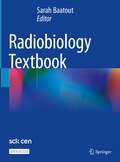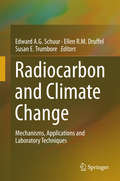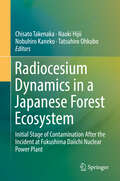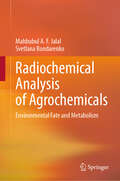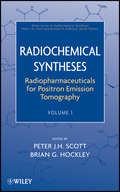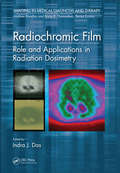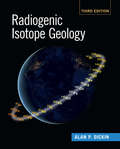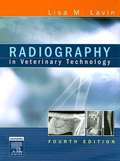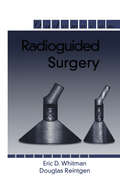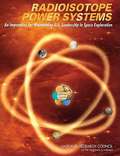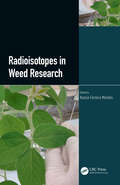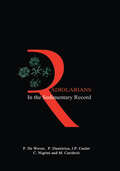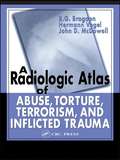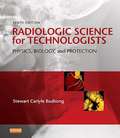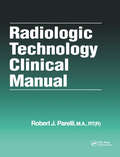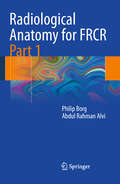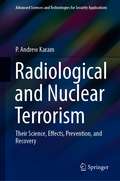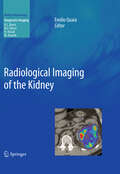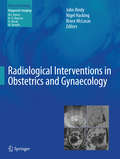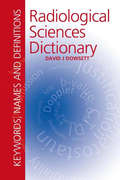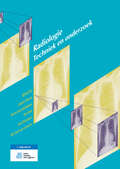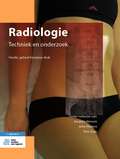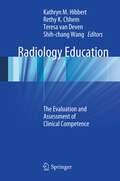- Table View
- List View
Radiobiology Textbook
by Sarah BaatoutThis open access textbook focuses on the various aspects of radiobiology. The goal of radiobiological research is to better understand the effects of radiation exposure at the cellular and molecular levels in order to determine the impact on health. This book offers a unique perspective, by covering not only radiation biology but also radiation physics, radiation oncology, radiotherapy, radiochemistry, radiopharmacy, nuclear medicine, space radiation biology & physics, environmental and human radiation protection, nuclear emergency planning, molecular biology and bioinformatics, as well as the ethical, legal and social considerations related to radiobiology. This range of disciplines contributes to making radiobiology a broad and rather complex topic. This textbook is intended to provide a solid foundation to those interested in the basics and practice of radiobiological science. It is a learning resource, meeting the needs of students, scientists and medical staff with an interest in this rapidly evolving discipline, as well as a teaching tool, with accompanying teaching material to help educators.
Radiocarbon and Climate Change
by Edward A. G. Schuur Ellen R. M. Druffel Susan E. TrumboreThis book is a useful guide for researchers in ecology and earth science interested in the use of accelerator mass spectrometry technology. The development of research in radiocarbon measurements offers an opportunity to address the human impact on global carbon cycling and climate change. Presenting radiocarbon theory, history, applications, and analytical techniques in one volume builds a broad outline of the field of radiocarbon and its emergent role in defining changes in the global carbon cycle and links to climate change. Each chapter presents both classic and cutting-edge studies from different disciplines involving radiocarbon and carbon cycling. The book also includes a chapter on the history and discovery of radiocarbon, and advances in radiocarbon measurement techniques and radiocarbon theory. Understanding human alteration of the global carbon cycle and the link between atmospheric carbon dioxide levels and climate remains one of the foremost environmental problems at the interface of ecology and earth system science. Many people are familiar with the terms 'global warming' and 'climate change', but fewer are able to articulate the science that support these hypotheses. This book addresses general questions such as: what is the link between the carbon cycle and climate change; what is the current evidence for the fate of carbon dioxide added by human activities to the atmosphere, and what has caused past changes in atmospheric carbon dioxide? How can the radiocarbon and stable isotopes of carbon combined with other tools be used for quantifying the human impact on the global carbon cycle?
Radiocesium Dynamics in a Japanese Forest Ecosystem: Initial Stage of Contamination After the Incident at Fukushima Daiichi Nuclear Power Plant
by Chisato Takenaka Naoki Hijii Nobuhiro Kaneko Tatsuhiro OhkuboThis book investigates radiocesium movement in all major components of forest ecosystems, e.g. the plants, animals, insects, microorganisms, and soils, during the initial stage of contamination after the incident at Fukushima Daiichi Nuclear Power Plant. Most of the work was conducted at a common research site.More specifically, the book examines the contribution of surface uptake by trees in the dynamics of radiocesium during the initial contamination stage; the movement of radiocesium in the form of small organic fragments that are essential to the radiocesium dynamics in forest ecosystems; and the upward movement of radiocesium due to microorganism activity, which promotes the effective decontamination of the forest floor. Lastly, it explains why spiders could be a valuable indicator of the contamination level in forest ecosystems.
Radiochemical Analysis of Agrochemicals: Environmental Fate and Metabolism
by Mahbubul A. Jalal Svetlana BondarenkoThis book provides an in-depth overview of agrochemicals, their development, regulation, and environmental impact. It also offers detailed insights into the latest research methodologies and regulatory standards. Through this comprehensive guide, readers will gain a thorough understanding of the complexities surrounding agrochemical use and its implications for modern agriculture. The chapters cover a wide range of topics including the history and evolution of crop protection methods, the regulatory framework governing agrochemicals, and the intricate processes of degradation and metabolism in various environments. Expert contributors discuss the nuances of radioactivity in agrochemical studies, quantitative and spectroscopic analysis techniques, and the behaviour of these chemicals in soil, water, plants, and livestock. Given its breadth, this book appeals to academics, practitioners, policymakers, and students interested in understanding the scientific principles and practical applications of agrochemicals. Researchers in the fields of agricultural science, environmental chemistry, and regulatory affairs will find this book invaluable.
Radiochemical Syntheses, Radiopharmaceuticals for Positron Emission Tomography
by Michael R. Kilbourn Peter J. Scott Brian G. HockleyThe ultimate reference guide to the synthesis of radiopharmaceuticalsThe Radiochemical Syntheses series provides scientists and professionals with a comprehensive reference to proven synthetic methods for radiochemical reactions, along with step-by-step guidance on how to replicate these syntheses in the laboratory.Volume 1 in the series focuses on the synthesis and purification of radiopharmaceuticals in clinical use today. It brings together in one complete, self-contained volume a collection of monographs containing a wealth of practical information from across the literature, demonstrating in meticulous detail how to prepare radiopharmaceuticals for positron emission tomography (PET) imaging, especially in tumor studies, cardiology, and neuroscience.Readers have key experimental details culled from the literature at their fingertips, greatly simplifying the process of qualifying a site for the clinical production of new radiopharmaceuticals.
Radiochromic Film: Role and Applications in Radiation Dosimetry (Imaging in Medical Diagnosis and Therapy)
by Indra J. DasThis book provides a first authoritative text on radiochromic film, covering the basic principles, technology advances, practical methods, and applications. It focuses on practical uses of radiochromic film in radiation dosimetry for diagnostic x-rays, brachytherapy, radiosurgery, external beam therapies (photon, electron, protons), stereotactic body radiotherapy, intensity-modulated radiotherapy, and other emerging radiation technologies. <P><P>The expert authors address basic concepts, advantages, and the main applications including kilovoltage, brachytherapy, megavoltage, electron beam, proton beam, skin dose, in vivo dosimetry, postal and clinical trial dosimetry. The final chapters discuss the state of the art in microbeam, synchrotron radiation, and ultraviolet radiation dosimetry.
Radiogenic Isotope Geochemistry
by Schaefer Bruce F.Isotopes provide important information on many geological processes, with key relevance to the mining and petroleum industries, yet the techniques to obtain, process and interpret the data can be complex to master. This accessible book provides broad coverage of radiogenic isotopes in geochronology and geochemistry, explaining the basic principles and state-of-the-art techniques used to study them, with an emphasis on industry applications. The major isotopic systems are fully summarised with relation to real-world applications, enabling readers to decide which technique is most relevant for the problem they want to solve, and then to rigorously evaluate existing data, or recalculate and reassess datasets to avoid duplication of effort. A comprehensive glossary clarifies the numerous acronyms used in the field. Written at a level appropriate for advanced undergraduate students, the book also includes detail which allows more experienced practitioners to maximise the potential value of isotopic datasets.
Radiogenic Isotope Geology (3rd Edition)
by Alan P. DickinModern isotope geochemistry is a rapidly expanding field that has a part to play in a broad range of earth and planetary sciences - from extra-solar system processes to environmental geoscience. this new edition of a popular textbook is completely updated and places more emphasis on the uses of radiogenic isotopes in environmental earth science. The author reviews the field of radiogenic isotope geology in a concise and visual manner to provide a comprehensive introduction to the subject and its wide variety of applications. For each technique, current ideas are presented in their historical context to allow the reader to understand the development of the theory. The latest ideas and methods, classic papers and case studies all come under scrutiny within this book. An accessible introduction for scientists from other disciplines and an important reference for students and researchers working in isotope geology.
Radiography in Veterinary Technology 4th Ed
by Lisa M. LavinWritten by a veterinary technician for veterinary technicians, students, and veterinary practice application, this concise, step-by-step text will help users consistently produce excellent radiographic images. It covers the physics of radiography, the origin of film artifacts, and positioning and restraint of small, large, avian, and exotic animals. It discusses everything from patient preparation, handling, and positioning to technical evaluation of the finished product.
Radioguided Surgery
by Eric WhitmanThis handbook is a review of radioguided surgical procedures, including sentinel node mapping and biopsy described by experts in the field. It is a practical guide for the practicing surgeon and other clinicians who will provide the majority of clinical care for breast cancer and other diseases and who therefore must be able to safely and effectively perform these procedures for their patients.
Radioisotope Power Systems: An Imperative for Maintaining U.S. Leadership in Space Exploration
by National Research Council of the National AcademiesSpacecraft require electrical energy. This energy must be available in the outer reaches of the solar system where sunlight is very faint. It must be available through lunar nights that last for 14 days, through long periods of dark and cold at the higher latitudes on Mars, and in high-radiation fields such as those around Jupiter. Radioisotope power systems (RPSs) are the only available power source that can operate unconstrained in these environments for the long periods of time needed to accomplish many missions, and plutonium-238 (238Pu) is the only practical isotope for fueling them. Plutonium-238 does not occur in nature. The committee does not believe that there is any additional 238Pu (or any operational 238Pu production facilities) available anywhere in the world.The total amount of 238Pu available for NASA is fixed, and essentially all of it is already dedicated to support several pending missions--the Mars Science Laboratory, Discovery 12, the Outer Planets Flagship 1 (OPF 1), and (perhaps) a small number of additional missions with a very small demand for 238Pu. If the status quo persists, the United States will not be able to provide RPSs for any subsequent missions.
Radioisotopes in Weed Research
by Kassio Ferreira MendesHerbicides are of great importance in weed management and are one of the most widely used pesticide groups for weed control across the globe. Concerns around the residual effects of these intensively used chemicals are equally widespread. Offering a new direction for research that focuses on herbicide behavior and its impacts on the environment, this book covers the use of radioisotopes in weed research and the detoxification of herbicides. Applying technological advances in radiation detection, Radioisotopes in Weed Research explains how isotopic techniques can be used to identify degradation products and trace the fate of herbicides applied to crop plants. This book provides essential information on the historical use and recent advances of radioisotopes in weed research. It demonstrates the potential these methods offer the field of weed science in gaining a better understanding of the behavior of herbicides in plants and soil and working to ensure the continuous, effective, and safe use of herbicides, minimizing harmful impacts on ecosystems. Features: Explains the radiometric method with studies of radiolabelled herbicides and includes case studies as examples Describes radiometric methods to study the behavior of herbicides in soil from transport and transformation to retention Elucidates the absorption, translocation, and metabolism studies of herbicides in plants Authored by a team of leading scientists, this book is written for professors, researchers, extensionists, graduate and undergraduate students, rural producers, and other professionals involved in weed science.
Radiolarians in the Sedimentary Record
by P. De Wever P. Dumitrica J.P. Caulet C. Nigrini M. CaridroitRadiolarians in the Sedimentary Record presents the current state of knowledge on fossil radiolarians. The author discusses the record, as well as new integrated taxonomic systems at the family level. The book provides comprehensive coverage of the fossil record of these unicellular organisms. It also discusses their important role in the history o
A Radiologic Atlas of Abuse, Torture, Terrorism, and Inflicted Trauma
by B. G. Brogdon Hermann Vogel John D. McDowellThe results of aggression against humans can be hideously obvious, but may also be entirely concealed from casual inspection. Often, only exploration of the hidden recesses of the mind via psychiatric evaluation, or radiologic exploration of the inner recesses of the body can reveal the evidence of such violence. This book focuses on the latter.<BR
Radiologic Science for Technologists: Physics, Biology and Protection (10th Edition)
by Stewart Carlyle BushongThis textbook provides a solid presentation of radiologic science, including the fundamentals of radiologic physics, diagnostic imaging, radio biology, and radiation management.
Radiologic Technology Clinical Manual
by Robert J. ParelliThe Radiologic Technology Clinical Manual is designed to guide students through all aspects of clinical training in the area of radiological sciences. This practical workbook contains student self-evaluation forms, course outlines, instructional objectives, and all the procedures and work assignments necessary for training students in the clinical side of radiologic technology. It can be used as a supplement to any radiologic sciences program.When used as part of an occupational training course in radiologic technology, the Radiologic Technology Clinical Manual will help students qualify for examination by the American Registry of Radiologic Technologists (ARRT). The book contains valuable record keeping materials for clinical experience hours, background on the profession as a whole, and evaluation forms for quarterly periods of clinical training. Time sheets, attendance forms, and clinical log forms are also included.
Radiological Anatomy for FRCR Part 1
by Abdul Rahman Alvi Philip BorgThe new FRCR part 1 Anatomy examination comprises 20 cases/images, with five questions about each. The cases are labelled 01 to 20 and the five questions are labelled (a) to (e). The authors have set out to emulate this format by gathering 200 cases which, from their experience, are representative of the cases on which candidates will be tested. The book consists of 10 tests with 20 cases each, and 5 stem questions each. The answers, along with an explanation and tips, accompany each test at the end of the chapter. This will help candidates to identify the level of anatomical knowledge expected by the Royal College of Radiologists. The aim of this book is not to replace the already available literature in radiological anatomy, but to complement it as a revision guide. Whereas radiological anatomy atlases and textbooks provide images with labels for every possible identifiable structure in an investigation, the cases in this book have only 5 labels, simulating the exam.
Radiological and Nuclear Terrorism: Their Science, Effects, Prevention, and Recovery (Advanced Sciences and Technologies for Security Applications)
by P. Andrew KaramThis book discusses multiple aspects of radiological and nuclear terrorism. Do you know what to do if there is a radiological or nuclear emergency in your city? These accidents are not common, but they have happened – and even though we have not seen an attack using these weapons, governments around the world are making plans for how to prevent them – and for how to respond if necessary. Whether you are an emergency responder, a medical caregiver, a public health official – even a member of the public wanting to know how to keep yourself and your loved ones safe – there is a need to understand how these weapons work, how radiation affects our health, how to stop an attack from taking place, how to respond appropriately in the event of an emergency, and much more.Unfortunately, the knowledge that is needed to accomplish all of this is lacking at all levels of society and government. In this book, Dr. Andrew Karam, an internationally respected expert in radiation safety and multiple aspects of radiological and nuclear emergencies, discusses how these weapons work and what they can do, how they can affect our health, how to keep yourself safe, and how to react appropriately whether you are a police officer investigating a suspect radiological weapon, a firefighter responding to a radiological or nuclear attack, a nurse or physician caring for potentially contaminated patients, or a governmental official trying to keep the public safe. To do this, he draws upon his extensive experience in the military, the several years he worked directly with emergency responders, his service on a number of advisory committees, and multiple trips overseas in the aftermath of the Fukushima accident and on behalf of the International Atomic Energy Agency, Interpol, and the Health Physics Society.
Radiological Imaging of the Kidney
by Emilio QuaiaThis book provides a unique and comprehensive analysis of the normal anatomy and pathology of the kidney and upper urinary tract from the modern diagnostic imaging point of view. The first part is dedicated to the normal radiological anatomy of the kidney and normal anatomic variants. The second part presents in detail all of the imaging modalities which can be employed to assess the kidney and the upper urinary tract, with careful descriptions of patient preparation, investigation protocols, and principal fields of application of each imaging modality. The entire spectrum of kidney pathologies is then presented with the aid of a large set of images, many of which are in color. The latest innovations in interventional radiology, biopsy procedures, and parametric and molecular imaging are also described. This book should be of great interest to all radiologists, oncologists, and urologists who are involved in the management of kidney pathologies in their daily clinical practice.
Radiological Interventions in Obstetrics and Gynaecology
by John Reidy Nigel Hacking Bruce MclucasThis book provides a state-of-the-art review of the technical and clinical aspects of the vascular interventional radiological (IR) procedures currently employed in obstetrics and gynaecology. A particular focus is on uterine artery embolisation for fibroid disease, which is contrasted with the main alternative uterus-conserving surgical approach of myomectomy, and with ablation therapy. Detailed consideration is also given to the role of embolisation in a variety of other less common conditions, including arteriovenous malformations, post-partum haemorrhage, abnormal placentation and pelvic congestion syndrome. IR procedures are examined from a critical gynaecological perspective and with regard to surgical alternatives. The authors include leading interventional radiologists and gynaecologists from the United Kingdom, Europe and North America.
Radiological Interventions in Obstetrics and Gynaecology (Medical Radiology)
by John Reidy Nigel Hacking Bruce McLucasThis book provides a state-of-the-art review of the technical and clinical aspects of the vascular interventional radiological (IR) procedures currently employed in obstetrics and gynaecology. A particular focus is on uterine artery embolisation for fibroid disease, which is contrasted with the main alternative uterus-conserving surgical approach of myomectomy, and with ablation therapy. Detailed consideration is also given to the role of embolisation in a variety of other less common conditions, including arteriovenous malformations, post-partum haemorrhage, abnormal placentation and pelvic congestion syndrome. IR procedures are examined from a critical gynaecological perspective and with regard to surgical alternatives. The authors include leading interventional radiologists and gynaecologists from the United Kingdom, Europe and North America.
Radiological Sciences Dictionary: Keywords, names and definitions
by David DowsettThe Radiological Sciences Dictionary is a rapid reference guide for all hospital staff employed in diagnostic imaging, providing definitions of over 3000 keywords as applied to the technology of diagnostic radiology.Written in a concise and easy to digest form, the dictionary covers a wide variety of subject matter, including:a radiation legislati
Radiologie: Techniek en onderzoek
by Jacques Hensen Karen Jaarsveld-Bolman Tom Dam José Dol-Jansen Sija Geers-van GemerenRadiologie maakt deel uit van de serie Medische Beeldvorming en Radiotherapie. De uitgave van deze boeken is een initiatief van het project Samenwerkingsverband Leermiddelen, in samenwerking met de redacties en auteurs uit het werkveld. Dit boek is een vervolg op en afgeleid van de boeken Techniek in de radiologie en Radiodiagnostisch onderzoek. Vanaf 2010 zijn deze twee boeken vervangen door drie delen, die sterk zijn uitgebreid en geactualiseerd:Computertomografie, Radiologie en Magnetic Resonance Imaging. Radiologie bevat een beschrijving van de r#65533;ntgentechniek en instelkunde, en daarnaast een overzicht van belangrijke ontwikkelingen op het gebied van digitalisering en kwaliteitsaspecten van het beroepsveld van de MBB'er (Medisch Beeldvormings- en Bestralingsdeskundige). Deel 1 Techniek beschrijft het basisprincipe van de radiologie en de toepassing hiervan in de praktijk. Nieuwe technische begrippen komen uitgebreid aan bod. Deel 2 gaat in op de strenge eisen op het gebied van kwaliteit en veiligheid die zowel aan de r#65533;ntgenapparatuur als aan de MBB'ers worden gesteld, waarbij ook de pati#65533;ntveiligheid aan bod komt. Deel 3 geeft een uitvoerige beschrijving van de instellingen voor het maken van standaardr#65533;ntgenopnamen met alle benodigde gegevens, ondersteund door fotomateriaal en illustraties. Hierbij is een onderverdeling gemaakt per tractus. Verder is er speciale aandacht voor mammografie, traumatologie en r#65533;ntgenonderzoek bij kinderen. Behalve voor MBB'ers in opleiding is Radiologie ook bij uitstek geschikt voor MBB'ers werkzaam in de radiologie, nucleaire geneeskunde en radiotherapie. Het boek is ook een goede introductie voor radiologen, al dan niet in opleiding, en een betrouwbaar naslagwerk voor artsen in opleiding.
Radiologie: Techniek en onderzoek (Medische beeldvorming en radiotherapie)
by Jacques Hensen John Peeters Tom DamDit boek beschrijft de röntgentechniek en instelkunde, en geeft een overzicht van belangrijke ontwikkelingen op het gebied van digitalisering en kwaliteitsaspecten van het beroepsveld van de MBB’er (Medisch Beeldvormings- en Bestralingsdeskundige). Deel 1 gaat in op het basisprincipe van de radiologie en de toepassing hiervan in de praktijk. Nieuwe technische begrippen komen uitgebreid aan bod. Deel 2 benoemt de strenge eisen op het gebied van kwaliteit en veiligheid die aan de röntgenapparatuur en aan de MBB’ers worden gesteld, waarbij ook de patiëntveiligheid aan bod komt. Deel 3 beschrijft de instellingen voor het maken van standaardröntgenopnamen met alle benodigde gegevens, ondersteund door fotomateriaal en illustraties. Er is een onderverdeling gemaakt per tractus. Verder is er speciale aandacht voor mammografie, traumatologie en röntgenonderzoek bij kinderen. Deze volledig herziene editie is geactualiseerd en aangepast volgens de huidige maatstaven. De techniek is op sommige punten verder ontwikkeld, er zijn verschillende nieuwe onderzoeken bij gekomen en andere onderzoeken zijn obsoleet geworden of vervangen door andere technieken zoals MRI, CT of echografie.Online zijn de teksten en afbeeldingen van het boek ook te raadplegen. Bij dit boek hoort een website die het mogelijk maakt om altijd en overal te studeren of informatie op te zoeken. Ook zijn hier oefenvragen per hoofdstuk beschikbaar die het mogelijk maken om verworven competenties en kennis te toetsen. Radiologie – Techniek en onderzoek maakt deel uit van de serie Medische Beeldvorming en Radiotherapie. Behalve voor MBB’ers in opleiding is dit boek bij uitstek geschikt voor MBB’ers werkzaam in de radiologie, nucleaire geneeskunde en radiotherapie. Het boek is ook een goede introductie voor radiologen, al dan niet in opleiding, en een betrouwbaar naslagwerk voor artsen in opleiding.
Radiology Education
by Kathryn M. Hibbert Rethy K. Chhem Teresa van Van Deven Shih-Chang WangThis book reviews the philosophies, theories, and principles that underpin assessment and evaluation in radiology education, highlighting emerging practices and work done in the field. The sometimes conflicting assessment and evaluation needs of accreditation bodies, academic programs, trainees, and patients are carefully considered. The final section of the book examines assessment and evaluation in practice, through the development of rich case studies reflecting the implementation of a variety of approaches. This is the third book in a trilogy devoted to radiology education. The previous two books focused on the culture and the learning organizations in which our future radiologists are educated and on the application of educational principles in the education of radiologists. Here, the trilogy comes full circle: attending to the assessment and evaluation of the education of its members has much to offer back to the learning of the organization.
